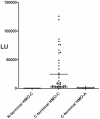Serological studies confirm the novel astrovirus HMOAstV-C as a highly prevalent human infectious agent
- PMID: 21829634
- PMCID: PMC3150362
- DOI: 10.1371/journal.pone.0022576
Serological studies confirm the novel astrovirus HMOAstV-C as a highly prevalent human infectious agent
Abstract
Molecular identification of a microbe is the first step in determining its prevalence of infection and pathogenic potential. Detection of specific adaptive immune responses can provide insights into whether a microbe is a human infectious agent and its epidemiology. Here we characterized human anti-IgG antibody responses by luciferase immunoprecipitation systems (LIPS) against two protein fragments derived from the capsid protein of the novel HMOAstV-C astrovirus. While antibodies to the N-terminal fragment were not informative, the C-terminal capsid fragment of HMOAstV-C showed a high frequency of immunoreactivity with serum from healthy blood donors. In contrast, a similar C-terminal capsid fragment from the related HMOAstV-A astrovirus failed to show immunoreactivity. Detailed analysis of adult serum from the United Sates using a standardized threshold demonstrated HMOAstV-C seropositivity in approximately 65% of the samples. Evaluation of serum samples from different pediatric age groups revealed that the prevalence of antibodies in 6-12 month, 1-2 year, 2-5 year and 5-10 year olds was 20%, 23%, 32% and 36%, respectively, indicating rising seroprevalence with age. Additionally, 50% (11/22) of the 0-6 month old children showed anti-HMOAstV-C antibody responses, likely reflecting maternal antibodies. Together these results document human humoral responses to HMOAstV-C and validate LIPS as a facile and effective approach for identifying humoral responses to novel infectious agents.
Conflict of interest statement
Figures




References
-
- Guix S, Bosch A, Pinto RM. Human astrovirus diagnosis and typing: current and future prospects. Lett Appl Microbiol. 2005;41:103–105. - PubMed
-
- Jonassen CM, Jonassen TO, Saif YM, Snodgrass DR, Ushijima H, et al. Comparison of capsid sequences from human and animal astroviruses. J Gen Virol. 2001;82:1061–1067. - PubMed
-
- Jonassen CM, Jonassen TT, Sveen TM, Grinde B. Complete genomic sequences of astroviruses from sheep and turkey: comparison with related viruses. Virus Res. 2003;91:195–201. - PubMed
-
- Clark B, McKendrick M. A review of viral gastroenteritis. Curr Opin Infect Dis. 2004;17:461–469. - PubMed
Publication types
MeSH terms
Substances
Grants and funding
LinkOut - more resources
Full Text Sources

